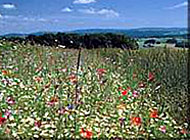Swiss launch early warning system for nature

Switzerland is set to conduct the most comprehensive biodiversity survey in the world. Field workers will monitor plants, animals, birds and insects in hundreds of test areas around the country.
The programme, announced by the Swiss environment agency on Thursday, will not only identify changes in the diversity of species but also spot problems at an early stage and form the basis for an effective nature conservation policy.
Erich Kohli from the environment agency said he hoped the programme would identify population trends early on and trigger corrective measures.
“The bigger goal is to have the politics which influence biodiversity – agriculture, forestry, road-building, settlements – working in a way that will preserve or even enrich biodiversity. We must give the decision-makers consistent and reliable data to show them whether they are getting it right or not and how to correct their policies.”
Scientists estimate that some 40,000 animal species and 3,000 plant species are found in Switzerland. The programme is monitoring changes at national, regional and habitat level to obtain a comprehensive picture.
“It is important to deal with common and widespread species as well as rare and threatened species,” said ecological consultant, Urs Hintermann.
“If you look at birds, which are one of the few groups where changes in species diversity have been fairly well documented, the figures show that in the last 100 years the number of species of birds has increased in Switzerland whereas population numbers of frequent species have declined. “
The fieldwork will be done in 500 test areas, each consisting of about one square kilometre. These areas have been further sub-divided into 1,600 units where individual species can be most conveniently studied.
Sampling areas for birds is about 3.1 hectares while soil samples for determining molluscs cover an area of 100 square centimetres.
Some 20 per cent of the sampling units will be examined each year so full results for the whole country will not be known for five years and any meaningful comparison will take at least ten.
“We are less interested in the absolute figures than the relative figures,” said Hintermann. “We want to know how things change over time because this is a programme designed for 50 or 100 years time.”
The survey allows Switzerland to meet one of the requirements of the Rio Convention on Biological Diversity, where it undertook to maintain and promote biodiversity. The programme will cost Sfr1.8 million a year.
by Vincent Landon

In compliance with the JTI standards
More: SWI swissinfo.ch certified by the Journalism Trust Initiative
You can find an overview of ongoing debates with our journalists here . Please join us!
If you want to start a conversation about a topic raised in this article or want to report factual errors, email us at english@swissinfo.ch.